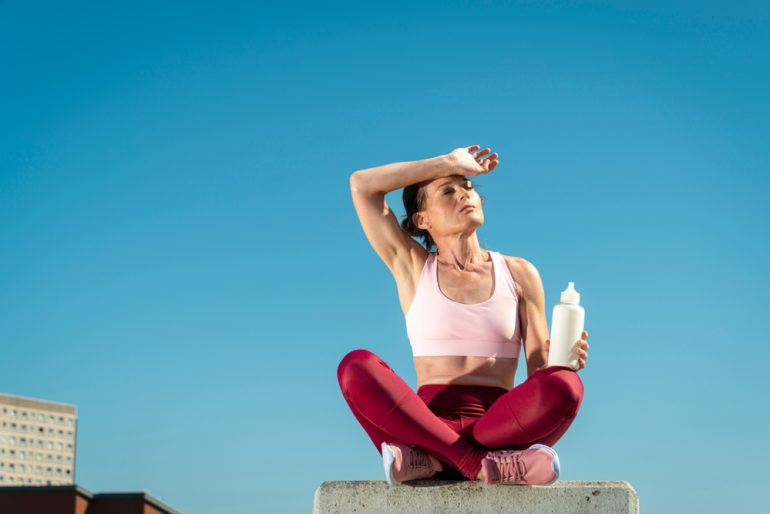10 Tips to Work Out in the Heat
From hot yoga to HIIT workouts in the bright sunshine, there are many options available if you want to explore exercising in the heat. While working out in the heat can often feel more difficult and strenuous, you can still do so safely and effectively if you take the right precautions and remain mindful of your environment.
In this article, we will discuss the benefits and drawbacks of working out in the heat and offer ten vital tips to keep you safe and make the most of your workouts in hot weather.
Working out in the heat
While a workout in hot weather or a class at a hot yoga studio can be intensely pleasurable, it is crucial to think about the specific advantages and risks of exercising in the heat before you bring your workout routines into the sunshine.
Benefits of exercising in the heat
Some of the benefits when exercising in the heat are:
- Increased calorie burn. While it is a popular misconception that working out in the heat increases calorie burn, in actuality, any more calories are mostly expended as a result of the additional effort needed to control body temperature. However, this can still result in a more demanding workout and perhaps even aid with weight loss objectives.
- Improved cardiovascular fitness. As your heart rate rises to transfer blood to the skin for cooling effects, exercising in the heat can improve cardiovascular fitness. This increased cardiovascular demand can strengthen your heart and increase your overall endurance.
- Heat adaptation. Regularly working out in the heat encourages your body to adjust and improves its capacity to expel heat. Your body gets better at controlling its temperature over time, enabling you to exercise comfortably in hotter weather.
Risks of exercising in the heat
Although increased calorie burn and improved cardio fitness might seem attracting there are definitely some risks to keep in mind:
- Dehydration. If fluids are not properly replaced, high temperatures and increased sweating can cause dehydration. Fatigue, lightheadedness, and potentially more serious problems can all result from dehydration.
- Heat exhaustion and heatstroke. Failure to take the essential precautions when exercising in extremely hot weather can lead to heat exhaustion or heatstroke. These conditions can make you extremely unwell and can even be fatal in some cases. Symptoms such as vertigo, nausea, a high body temperature, and confusion can be signs of heatstroke and heat exhaustion — seek medical advice if you experience any of these symptoms.
- Sunburn and skin damage. Without the right sun protection, exercising outside can result in sunburn and long-term skin damage. It is important to use sunscreen, wear protective gear, and seek out cover as necessary.
Working out in the heat vs. cold
Working out in the heat brings its own set of considerations, but how does it compare to exercising in the cold?
10 tips for working out in the heat
If you want to work out in the heat and enjoy the benefits of moving your body under the open sky — follow these ten tips to make sure you do so safely.
- Remain hydrated. The importance of water consumption before, during, and after exercise cannot be emphasized enough — so bring a big bottle out into the sunshine with you when you work out. Minerals and fluids lost during exercise can be replaced with water, electrolyte beverages, and coconut water.
- Timing your workouts. Plan your workouts for when it is cooler outside, particularly in the early morning or late evening when it is less hot.
- Dress appropriately. Wear clothing that is breathable, moisture-wicking, and lightweight to improve airflow. Dress in soft hues to reflect sunlight.
- Keep your skin safe. It’s a good idea to wear a hat to shade your face, put on some sunglasses, and apply sunscreen with a high SPF to exposed skin to protect your eyes and skin from the sun’s harmful rays.
- Adjust gradually. Allow your body to gradually adjust to working out in the heat. Start with shorter workouts and progressively build up to longer and more intense sessions over time.
- Listen to your body. Pay alert to symptoms of heat-related problems such as nausea, weariness, or dizziness. If you notice any signs, stop exercising right away and find some shade.
- Opt for shade. If at all feasible, exercise in locations with shade, or shield yourself from the sun using umbrellas or canopies.
- Take breaks. Include rest periods in your training to help your body recuperate and cool down.
- Eat hydrating foods. In addition to drinking plenty of water, you can improve hydration levels by eating lots of meals packed with delicious fruits and vegetables with high water content. Oranges, cucumbers, and melons are great snack ideas to try pre and post-workout.
- Be mindful of humidity. High humidity might hinder sweat’s ability to evaporate, which decreases your body’s capacity to cool down. In humid weather, take extra measures, such as lowering your activity intensity or duration.
Working out in the heat has a lot to offer — you get to experience the physical and mental health benefits of biophilia workouts. Knowing the best ways to protect yourself in hot weather can empower you to maximize your workout and minimize the risks of working out in the sunshine.
FAQ
Why is it harder to work out in the heat?
Exercising in the heat becomes more challenging because it increases the cardiovascular strain as the body tries to regulate its temperature, leading to a higher heart rate and increased dehydration risks.
Can I work out in hot weather?
Yes, you can absolutely work out in hot weather, but you should follow advice such as staying hydrated, dressing appropriately, and planning your workouts during cooler times of the day to ensure your safety and well-being.

